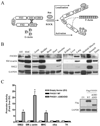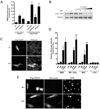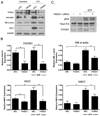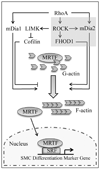Formin homology domain-containing protein 1 regulates smooth muscle cell phenotype
- PMID: 21106951
- PMCID: PMC3025477
- DOI: 10.1161/ATVBAHA.110.212993
Formin homology domain-containing protein 1 regulates smooth muscle cell phenotype
Abstract
Objective: Our goal was to test whether formin homology protein 1 (FHOD1) plays a significant role in the regulation of smooth muscle cell (SMC) differentiation and, if so, whether Rho kinase (ROCK)-dependent phosphorylation in the diaphanous autoinhibitory domain is an important signaling mechanism that controls FHOD1 activity in SMC.
Methods and results: FHOD1 is highly expressed in aortic SMCs and in tissues with a significant SMC component. Exogenous expression of constitutively active FHOD1, but not wild-type, strongly activated SMC-specific gene expression in 10T1/2 cells. Treatment of SMC with the RhoA activator sphingosine-1-phosphate increased FHOD1 phosphorylation at Thr1141, and this effect was completely prevented by inhibition of ROCK with Y-27632. Phosphomimetic mutations to ROCK target residues enhanced FHOD1 activity, suggesting that phosphorylation interferes with FHOD1 autoinhibition. Importantly, knockdown of FHOD1 in SMC strongly inhibited sphingosine-1-phosphate-dependent increases in SMC differentiation marker gene expression and actin polymerization, suggesting that FHOD1 plays a major role in RhoA-dependent signaling in SMC.
Conclusions: Our results indicate that FHOD1 is a critical regulator of SMC phenotype and is regulated by ROCK-dependent phosphorylation. Thus, additional studies on the role of FHOD1 during development and the progression of cardiovascular disease will be important.
Figures






Similar articles
-
The mammalian formin FHOD1 is activated through phosphorylation by ROCK and mediates thrombin-induced stress fibre formation in endothelial cells.EMBO J. 2008 Feb 20;27(4):618-28. doi: 10.1038/emboj.2008.7. Epub 2008 Jan 31. EMBO J. 2008. PMID: 18239683 Free PMC article.
-
Activation of the Rac-binding partner FHOD1 induces actin stress fibers via a ROCK-dependent mechanism.J Biol Chem. 2003 Oct 3;278(40):38902-12. doi: 10.1074/jbc.M306229200. Epub 2003 Jul 10. J Biol Chem. 2003. PMID: 12857739
-
Formin homology domain protein (FHOD1) is a cyclic GMP-dependent protein kinase I-binding protein and substrate in vascular smooth muscle cells.J Biol Chem. 2004 Jun 4;279(23):24420-6. doi: 10.1074/jbc.M313823200. Epub 2004 Mar 29. J Biol Chem. 2004. PMID: 15051728
-
Formins as effector proteins of Rho GTPases.Small GTPases. 2014;5:e29513. doi: 10.4161/sgtp.29513. Epub 2014 Jun 10. Small GTPases. 2014. PMID: 24914801 Free PMC article. Review.
-
Formin-binding proteins: modulators of formin-dependent actin polymerization.Biochim Biophys Acta. 2010 Feb;1803(2):174-82. doi: 10.1016/j.bbamcr.2009.06.002. Epub 2009 Jul 7. Biochim Biophys Acta. 2010. PMID: 19589360 Review.
Cited by
-
Comprehensive Profiles of mRNAs and miRNAs Reveal Molecular Characteristics of Multiple Organ Physiologies and Development in Pigs.Front Genet. 2019 Aug 28;10:756. doi: 10.3389/fgene.2019.00756. eCollection 2019. Front Genet. 2019. PMID: 31552085 Free PMC article.
-
Prdm6 drives ductus arteriosus closure by promoting ductus arteriosus smooth muscle cell identity and contractility.JCI Insight. 2023 Mar 8;8(5):e163454. doi: 10.1172/jci.insight.163454. JCI Insight. 2023. PMID: 36749647 Free PMC article.
-
Signaling mechanisms that regulate smooth muscle cell differentiation.Arterioscler Thromb Vasc Biol. 2011 Jul;31(7):1495-505. doi: 10.1161/ATVBAHA.110.221135. Arterioscler Thromb Vasc Biol. 2011. PMID: 21677292 Free PMC article. Review.
-
Gene coexpression networks reveal key drivers of phenotypic divergence in porcine muscle.BMC Genomics. 2015 Feb 5;16(1):50. doi: 10.1186/s12864-015-1238-5. BMC Genomics. 2015. PMID: 25651817 Free PMC article.
-
Thoracic aortic aneurysm (TAAD)-causing mutation in actin affects formin regulation of polymerization.J Biol Chem. 2012 Aug 17;287(34):28398-408. doi: 10.1074/jbc.M112.371914. Epub 2012 Jun 29. J Biol Chem. 2012. PMID: 22753406 Free PMC article.
References
-
- Owens GK, Kumar MS, Wamhoff BR. Molecular regulation of vascular smooth muscle cell differentiation in development and disease. Physiol Rev. 2004;84:767–801. - PubMed
-
- Landerholm TE, Dong XR, Lu J, Belaguli NS, Schwartz RJ, Majesky MW. A role for serum response factor in coronary smooth muscle differentiation from proepicardial cells. Development. 1999;126:2053–2062. - PubMed
-
- Niu Z, Yu W, Zhang SX, Barron M, Belaguli NS, Schneider MD, Parmacek M, Nordheim A, Schwartz RJ. Conditional mutagenesis of the murine serum response factor gene blocks cardiogenesis and the transcription of downstream gene targets. J Biol Chem. 2005;280:32531–32538. - PubMed
Publication types
MeSH terms
Substances
Grants and funding
LinkOut - more resources
Full Text Sources
Molecular Biology Databases
Research Materials

